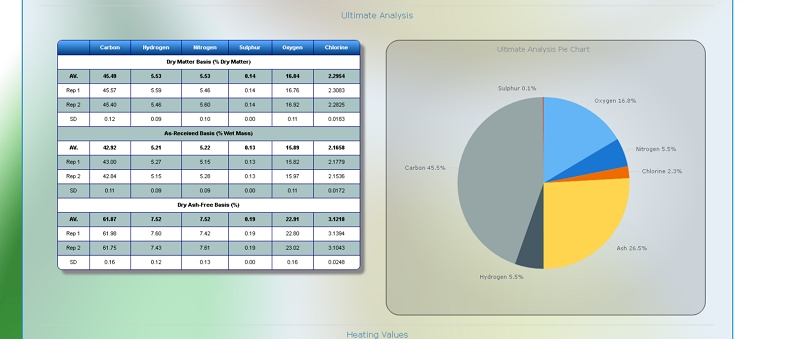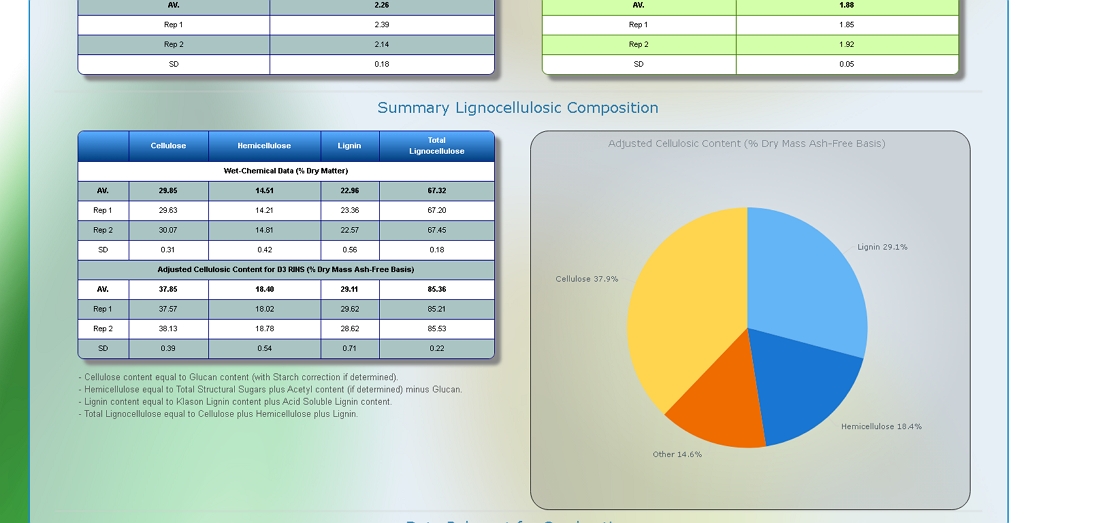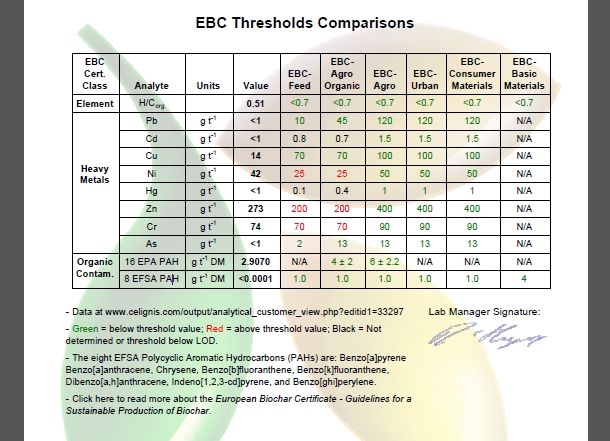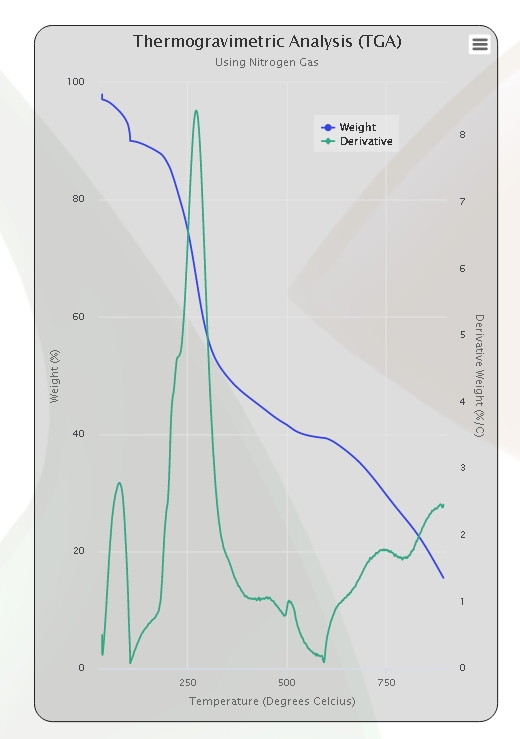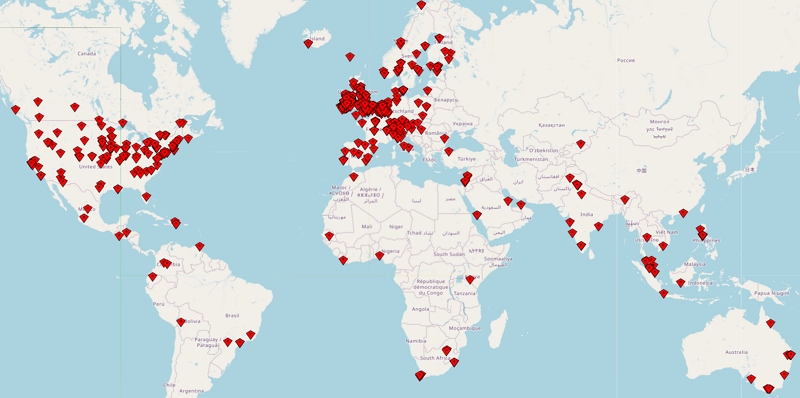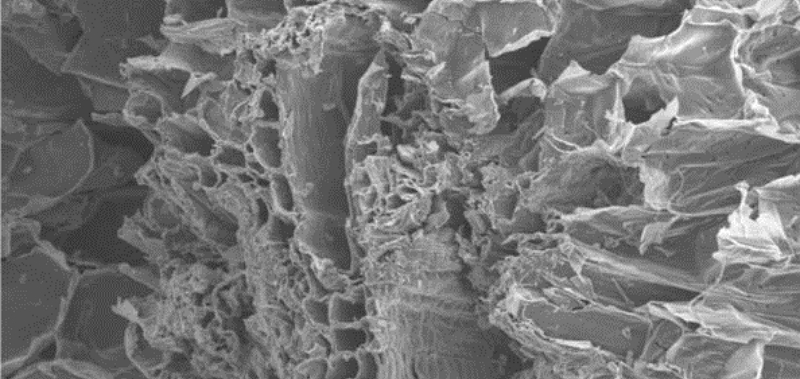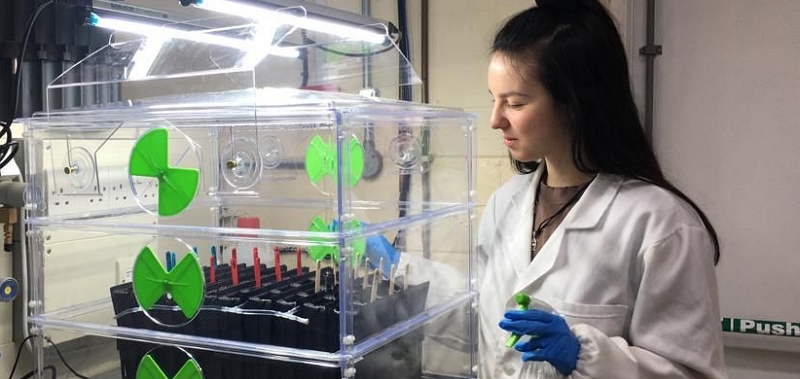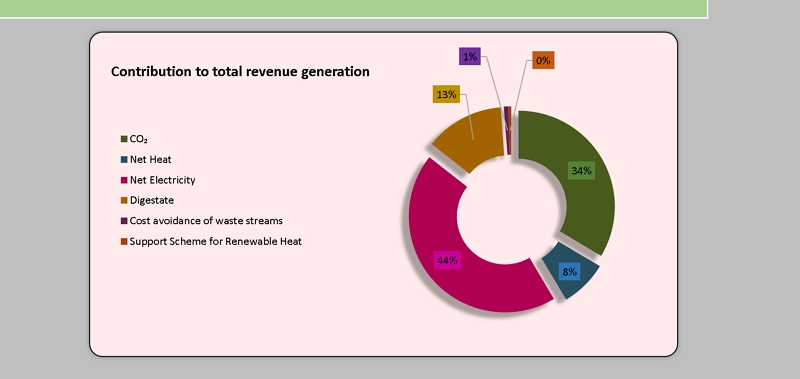Analysis of Feedstocks for the Production of Biochar
There are two key considerations when producing biochar from biomass:
1. Biochar Yield - Defined as the percentage by mass of the original biomass that ends up as biochar.
2. Biochar Quality - A wide-encompassing term that considers how suitable the physical and chemical properties of the biochar are for the desired end-use.
Both of these parameters are affected by the conditions under which the feedstock is pyrolysed. These conditions include temperature, heating rate, and residence time. For example, high temperatures will lead to lower yields of biochar, as more of the biomass becomes volatile at higher temperatures, but can also result in the formation of a biochar of higher quality for certain applications (for example those that require a material of a higher carbon content).
How Feedstocks can Influence Biochar Yield and Quality
Under this assumption, it is useful to consider how each of the main constituents of biomass behave when exposed to prolysis conditions.
Cellulose
Lignocellulosic biomass feedstocks are the most abundant type of biomass. They are primarily composed of lignin and the polysaccharides cellulose and hemicellulose, along with smaller amounts of extractives and ash.Cellulose undergoes a series of stages of degradation in the pyrolysis process, starting with dehydration at lower temperatures (100 to 200 oC), followed by depolymerisation at temperatures of 314 to 400 oC, with carbonisation leading to biochar production at temperatures over 400 oC. Cellulose is mostly volatile in slow-pyrolysis conditions meaning that much of the polymer will end up in the (non-condensible) gas rather than the biochar.
Hemicellulose
While cellulose is a homopolymer composed of only one sugar (glucose), hemicellulose is a complex polysaccharide that can contain other sugars. There are a number of different types of hemicellulose, these differ according to the sugar units that constitute the main backbone of the polymer as well as according to the amount and composition of the side-groups attached to this backbone.Due to their heterogeneity, different hemicelluloses behave in different ways in slow-pyrolysis. However, in general, hemicellulose degrades at a lower temperature (220 to 315 oC) than cellulose. Given the more volatile nature of this polysaccharide, biochar yields from hemicellulose are even lower than from cellulose, with the majority of the material ending up in the (non-condensable) gas.
Lignin
lignin is a highly heterogeneous cross-linked polymer composed of aromatic subunits. It has a higher carbon content than cellulose and hemicellulose and also experiences a more gradual profile for decomposition than these polymers, with the temperature range being 250 to 500 oC. There are characteristic differences in lignin composition between hardwoods, softwoods, and herbaceous feedstocks.Lignin typically produces higher biochar yields than cellulose and hemicellulose, with lesser amounts of the polymer ending up in the gas or liquid fractions.
Extractives
Extractives are defined as extraneous components that may be separated from the insoluble cell wall material by their solubility in water or neutral organic solvents. Solvents of different polarities are required to remove different types of extractives. Hence the extractives are often classified according to which solvent can extract them (e.g. ethanol-soluble-extractives).Generally, extractives are more volatile than the structural components of biomass (cellulose, hemicellulose, and lignin) and therefore undergo thermal degradation at lower temperatures. This means that the majority of the extractives are likely to go to gas, rather than biochar, production in slow pyrolysis.
Protein
Different proteins have varying thermal stabilities and undergo different thermal degradation pathways during pyrolysis. Furthermore, the presence of nitrogen-containing compounds resulting from protein pyrolysis can have implications for the use of biochar as a soil amendment. Nitrogen is an essential nutrient for plant growth, and biochar produced from nitrogen-rich biomass can be a source of plant-available nitrogen in soil. However, the availability of nitrogen from biochar can vary depending on the pyrolysis conditions and the specific nitrogen-containing compounds formed during pyrolysis.Ash
Ash wil be retaining in the biochar as it will not become volatile under the conditions employed for slow-pyrolysis. However, during pyrolysis, ash does undergo thermal transformation, which leads to the formation of a range of compounds, including oxides, carbonates, and silicates. At higher temperatures, ash undergoes more rapid thermal transformation, leading to a higher yield of oxides and silicates. Conversely, at lower temperatures, ash undergoes slower thermal transformation, leading to a higher yield of carbonates.The presence of ash in biochar can have implications for its use as a soil amendment. Ash can be a source of plant nutrients, such as potassium, calcium, and magnesium, which can enhance plant growth. However, ash can also contain potentially toxic elements, such as heavy metals, which can accumulate in soil and pose a risk to plant and human health. Hence, it is important that the composition of ash and the potential presence of toxic elements should be considered when selecting biomass feedstocks for biochar production.
Lignocellulosic Composition
At Celignis we offer a wide range of lignocellulose analysis packages (as detailed here), however for the evaluation of candidate feedstocks for biochar production we would recommend packages P10 or P19, as detailed here.
Total Sugars, Glucose, Xylose, Mannose, Arabinose, Galactose, Rhamnose, Lignin (Klason), Lignin (Acid Soluble), Acid Insoluble Residue, Extractives (Ethanol-Soluble), Extractives (Water-Soluble), Extractives (Exhaustive - Water then Ethanol), Extractives (Water-Insoluble, Ethanol Soluble) , Ash, Ash (Acid Insoluble)
Total Sugars, Glucose, Xylose, Mannose, Arabinose, Galactose, Rhamnose, Lignin (Klason), Lignin (Klason - Protein Corrected), Lignin (Acid Soluble), Acid Insoluble Residue, Extractives (Ethanol-Soluble), Extractives (Water-Soluble), Extractives (Exhaustive - Water then Ethanol), Extractives (Water-Insoluble, Ethanol Soluble) , Ash, Ash (Acid Insoluble), Glucuronic Acid, Galacturonic Acid, 4-O-Methyl-D-Glucuronic Acid, Protein Content of Acid Insoluble Residue, Carbon Content of Acid Insoluble Residue, Hydrogen Content of Acid Insoluble Residue, Nitrogen Content of Acid Insoluble Residue, Sulphur Content of Acid Insoluble Residue, Xylitol, Sucrose, Fructose, Sorbitol, Trehalose
Request a QuoteLignocellulose
Major and Minor Elements
For example, the European Biochar Certificate (EBC), an organisation set up to ensure the quality and safety of biochar produced in Europe, sets thresholds for the upper limits for the amounts of certain heavy metals in biochar. These threshold values vary according to the planned end-use of the biochar. For example, the limit for the arsenic content of biochar to be used in animal feed applications is 2ppm whilst this limit rises to 13ppm if the biochar is to be used in consumer biomaterials.
At Celignis we can profile your potential biochar feedstocks for their major and minor elements and then, based on an estimate of the expected biochar yield, the expected amount of each element in the resulting biochar can be calculated. For example, if your feedstock has a zinc content of 20ppm and it is expected that the biochar yield would be 20%, then the zinc content of the final biochar can be estimated to be 100pm.
Such expected values can then be compared against threshold upper limits, from EBC or other institutions, to see if the resulting biochar would qualify for the desired end-use.
Such a pre-screening approach would be much more cost-effective than producing a biochar sample and then analysing it for its heavy metals contents.
Request a QuoteHeavy Metals
Ultimate Analysis and Protein Content
We have a number of analysis packages that can determine the carbon content of a feedstock using the Dumas analysis method. This method also allows for the determination of the hydrogen, nitrogen, and sulphur contents, with the oxygen content calculated by difference (considering the ash also present).
The determination of nitrogen content of the feedstock is also important when considering the targetted end-use for the biochar, particularly if soil-amendment is being considered. Protein content can be estimated from the nitrogen content by multiplying it by a conversion factor relevant to the type of feedstock (for example a factor of 6.25 is used for many types of biomass). However, if a greater understanding of the protein composition of the feedstock is required then we can analyse the sample for its amino acid composition (package P17).
Volatile Matter, Fixed Carbon, Moisture, Ash, Carbon, Hydrogen, Nitrogen, Sulphur, Oxygen, Gross Calorific Value, Net Calorific Value, Chlorine, Ash Shrinkage Starting Temperature (Reducing), Ash Deformation Temperature (Reducing), Ash Hemisphere Temperature (Reducing), Ash Flow Temperature (Reducing), Aluminium, Calcium, Iron, Magnesium, Phosphorus, Potassium, Silicon, Sodium, Titanium
Request a QuoteUltimate Analysis
If nitrogen is used then the sample will be heated under pyrolysis conditions (i.e. with no oxygen). This means that estimates can be made for the potential biochar yield at a given temperature or that a pyrolysis temperature can be selected for a particular yield of biochar.
TGA is a cost-effective method for screening potential biochar feedstocks for their behaviours under pyrolysis conditions without having to produce biochar in a pyrolysis reactor.
Relevant packages for the thermogravimetric analysis of feedstocks are listed below:
Thernogram - Under Nitrogen, Thermogram - Under Air, Moisture, Inherent Moisture, Ash Content (815C), Carbon, Hydrogen, Nitrogen, Sulphur, Oxygen, Organic Carbon, Inorganic Carbon, Chlorine, Volatile Matter, Fixed Carbon, Aluminium, Calcium, Iron, Magnesium, Phosphorus, Potassium, Silicon, Sodium, Titanium, Gross Calorific Value, Net Calorific Value, Ash Shrinkage Starting Temperature (Reducing), Ash Deformation Temperature (Reducing), Ash Hemisphere Temperature (Reducing), Ash Flow Temperature (Reducing)
Thernogram - Under Nitrogen, Thermogram - Under Air, Moisture, Inherent Moisture, Ash Content (815C), Carbon, Hydrogen, Nitrogen, Sulphur, Oxygen, Organic Carbon, Inorganic Carbon, Chlorine, Volatile Matter, Fixed Carbon, Specific Surface Area (Nitrogen Gas Adsorption), Calcium, Iron, Magnesium, Phosphorus, Potassium, Silicon, Sodium, Titanium, Gross Calorific Value, Net Calorific Value, Ash Shrinkage Starting Temperature (Reducing), Ash Deformation Temperature (Reducing), Ash Hemisphere Temperature (Reducing), Ash Flow Temperature (Reducing)
Click here to read more about the thermogravimetric analysis of biomass.

Sajna KV
Bioanalysis Head
PhD
<p style="text-align: left;">Our Biomass Detective! Designs, tests, optimizes and validates robust analytical methods for properties of relevance to the various biochar market applications.</p>

Dan Hayes
Celignis CEO And Founder
PhD (Analytical Chemistry)
<p style="text-align: left;">Dreamer and achiever. Took Celignis from a concept in a research project to being the bioeconomy's premier provider of analytical and bioprocessing expertise.</p>
Global Recognition as Biomass and Biochar Experts
Biochar Production
Biochar Analysis
Biochar Combustion Properties
Soil Amendment & Plant Growth Trials
Analysis of PAHs in Biochar
Surface Area and Porosity of Biochar
Thermogravimetric Analysis of Biochar
Biochar Upgrading
Biochar for Carbon Sequestration
Technoeconomic Analyses of Biochar Projects
Research Project Collaborations
Hydrothermal carbonization (HTC) research has mainly focused on primary char production, with limited attention to secondary char, which is formed through polymerization and condensation of dissolved organic compounds in the liquid phase. This research aims to address this gap via an experimental investigation of the impact of stirring on the mass and carbon balance of HTC reaction products, surface functional groups, and surface morphology of secondary char, using fructose as a model compound. A 3D hydrodynamic simulation model was developed for a two-liter HTC stirred reactor. The experimental results indicated that stirring did not significantly influence the pH, mass, carbon balance, and surface functional groups of secondary char produced under the range of experimental conditions (180 C, 10% biomass to water (B/W) ratio, and a residence time of 0-120 min) studied. Nonetheless, it was observed that a stirring rate of 200 rpm influenced the morphology and shape of the secondary char microspheres, leading to a significant increase in their size i.e., from 1-2 um in unstirred conditions compared with 70 um at a stirring rate of 200 rpm. This increase in size was attributed to the aggregation of microspheres into irregular aggregates at stirring rates > 65 rpm and residence times > 1 h. The hydrodynamic model revealed that high turbulence of Re > 104 and velocities > 0.17 m s-1 correlated with regions of secondary char formation, emphasizing their role in particle aggregation. Particle aggregation is significant above a stirring rate of 65 rpm, which corresponds to the onset of turbulent flow in the reactor. Finally, a mechanism is proposed, based on reactor hydrodynamics under stirred conditions, that explains secondary char deposition on the reactor walls and stirrer. | |
A dried dairy processing sludge (sludge from wastewater treatment of an effluent from a milk processing plant) was pyrolysed in a single-particle reactor at different temperatures from 400 C to 900 C. NH3 and HCN were measured online and offline by means of FTIR as well as by cumulative sampling in impinger bottles (in 0.05 M H2SO4 and 1 M NaOH, respectively) and analysed by photometric method. NO and NO2 were measured online using a nitric oxide analyser while N2O was measured by FTIR. Nitrogen (N) in the sludge and in the remaining char, char-N, was determined. Moreover, tar content in pyrolysis gas was measured and tar-N was determined. The results with respect to N mass balance closure are discussed. The different measurements techniques are compared. For pyrolysis at 520 and 700 nitrogen in the gas phase was mainly contained as N2 (36 % and 40 % respectively), followed by NH3 (15 % and 18 %), tar-N (10 % and 9 %), HCN (1 % and 3 %), NO (1 %) and NO2 (0.2 %). The dairy processing sludge has very specific properties with organic-N present predominantly as proteins and a high content of inherent Ca. These characteristics affected the distribution of N. The amount of char-N was higher while the amount of tar-N lower than for sewage sludge from literature, at comparable pyrolysis temperature. | |
Dairy processing sludge (DPS) is a byproduct generated in wastewater treatment plants located in dairy (milk) processing companies (waste activated sludge). DPS presents challenges in terms of its management (as biosolids) due to its high moisture content, prolonged storage required, uncontrolled nutrient loss and accumulation of certain substances in soil in the proximity of dairy companies. This study investigates the potential of hydrothermal carbonization (HTC) for recovery of nutrients in the form of solid hydrochar (biochar) produced from DPS originating from four different dairy processing companies. The HTC tests were carried out at 160 C, 180 C, 200 C and 220 C, and a residence time of 1h. The elemental properties of hydrochars (biochars), the content of primary and secondary nutrients, as well as contaminants were examined. The transformation of phosphorus in DPS during HTC was investigated. The fraction of plant available phosphorus was determined. The properties of hydrochar (biochar) were compared against the European Union Fertilizing Products Regulation. The findings of this study demonstrate that the content of nutrient in hydrochars (biochars) meet the requirements for organo-mineral fertilizer with nitrogen and phosphorus as the declared nutrients (13.9-26.7%). Further research on plant growth and field tests are needed to fully assess the agronomic potential of HTC hydrochar (biochar). | |
Disposal of waste-activated sludge [dairy processing sludge, (DPS)] from wastewater treatment plants located in milk processing companies is an increasing concern. DPS is usually applied to farmlands in the vicinity of the dairy companies. This practice is becoming unsustainable due to uncontrolled nutrient loss and potential soil contamination. We propose to recover nutrients in the form of biochar. This paper examines the properties of biochars obtained from slow pyrolysis of DPS. DPS samples were pyrolyzed at laboratory and pilot scale at 600 and 700 C. The elemental properties of biochars, the content of primary and secondary nutrients, as well as contaminants were examined and compared against the European Union Fertilizing Products Regulation. The biochars meet the specified limits for hydrogen-to-organic carbon ratio, chloride, and polycyclic aromatic hydrocarbons intended for gasification and pyrolysis component category materials. In six out of eight biochars, the content of phosphorus (P) as a single declared nutrient and the level of contaminants meet those required for an organo-mineral fertilizer. Only two biochars meet the required concentrations of nitrogen, phosphorus, and potassium. A minimum solid content of 30% in DPS is required to make the process of biochar production energetically sustainable. | |
Anaerobically digested sewage sludge mixed with forest residues was pyrolysed at 800 C, at laboratory and pilot scale. The study quantified differences in char and gas yields for tests carried out in a simple fixed bed laboratory reactor and rotating retort pyrolyser at pilot scale, when the residence time of feedstock was 10 min in both cases. The yield of char from pilot scale was 4 % lower than from laboratory scale while the yield of gas was 15.7 % higher. During the pilot scale pyrolysis of anaerobically digested sewage sludge blended with forest residues the gas quality for energy recovery applications was assessed and the fate of impurities (tar, NH3 and H2S) was investigated. The raw pyrolysis gas contained 14.6 g/Nm3 of tar, 36.9 g/Nm3 of NH3 and 793 ppm of H2S. Sixteen N-containing tar species were identified of which pyridine, propenenitrile, 2-methyl-, benzonitrile, and indole are found to be the most abundant. The yield of N-containing tar compounds accounted for approx. 12 % of total tar content. Conditioned pyrolysis gas contained 7.1 g/Nm3 of tar, 0.036 g/Nm3 of NH3 and 119 ppm of H2S. Benzene was by far the most abundant tar compound followed by toluene and styrene. The specifications of the used internal combustion engine were exceeded due to the sum of tar compounds such as fluorantrene and pyrene with 4+ aromatic rings (at 0.0015 g/Nm3) and NH3 content The effectiveness and sustainability of energy recovery in wastewater treatment can be improved using forest industry by-products. | |
Adsorption of six contaminants of emerging concern (CECs) - caffeine, chloramphenicol, carbamazepine, bisphenol A, diclofenac, and triclosan - from a multicomponent solution was studied using activated biochars obtained from three lignocellulosic feedstocks: wheat straw, softwood, and peach stones. Structural parameters related to the porosity and ash content of activated biochar and the hydrophobic properties of the CECs were found to influence the adsorption efficiency. For straw and softwood biochar, activation resulted in a more developed mesoporosity, whereas activation of peach stone biochar increased only the microporosity. The most hydrophilic CECs studied, caffeine and chloramphenicol, displayed the highest adsorption (22.8 and 11.3 mg g-1) onto activated wheat straw biochar which had the highest ash content of the studied adsorbents (20 wt%). Adsorption of bisphenol A and triclosan, both relatively hydrophobic substances, was highest (31.6 and 30.2 mg g-1) onto activated biochar from softwood, which displayed a well-developed mesoporosity and low ash content. | |
Magnetic carbons can significantly lower the costs of wastewater treatment due to easy separation of the adsorbent. However, current production techniques often involve the use of chlorinated or sulfonated Fe precursors with an inherent potential for secondary pollution. In this study, ochre, an iron-rich waste stream was investigated as a sustainable Fe source to produce magnetic activated biochar from two agricultural feedstocks, softwood and wheat straw. Fe doping resulted in significant shifts in pyrolysis yield distribution with increased gas yields (+50%) and gas energy content (+40%) lowering the energy costs for production. Physical activation transformed ochre to magnetite/maghemite resulting in activated magnetic biochars and led to a 4-fold increase in the adsorption capacities for two common micropollutants - caffeine and fluconazole. The results show that Fe doping not only benefits the adsorbent properties but also the production process, leading the way to sustainable carbon adsorbents. | |
The majority of the sludge from the treatment of wastewater in milk processing plants is land spread. The drawbacks of land spreading include local oversupply due to high transport costs, which results in sludge being spread on lands in the vicinity of the dairy factories. Local oversupply can lead to accumulation of certain substances in soil through annual application over many years. Therefore, in the long term, there is a need for alternative methods to recover energy and nutrients from increasing volumes of sludge generated from dairy processing. Pyrolysis offers a potential alternative to land spreading, which can reduce health and environmental risks, while providing an avenue for the recovery of energy and nutrients. Pyrolysis allows energy recovery in the form of a high calorific value pyrolysis gas and a char which may be used as a soil amendment. In this study pyrolysis of dried dairy sludge was carried out at pilot scale. The results indicate that a dried biological sludge can be successfully pyrolysed and when mixed with wood the resulting char meets European Biochar Certificate criteria regarding carbon content. Most of the initial energy content of the feedstock was retained in the pyrolysis gas prior to cleaning, 53%, compared to 34.5% in the char and 1.5% in the tar. For the pyrolysis gas after cleaning (mainly cracking in presence of air) the initial energy content of the feedstock retained in the gas was only slightly higher than that retained in the char, 39.2% versus 34.5%, while the tar accounted for 0.8% of the initial energy content. | |
Eucalypts can be very productive when intensively grown as short rotation woody crops (SRWC) for bioproducts. In Florida, USA, a fertilized, herbicided, and irrigated cultivar planted at 2471 trees/ha could produce over 58 green mt/ha/year in 3.7 years, and at 2071 trees/ha, its net present value (NPV) exceeded $750/ha at a 6% discount rate and stumpage price of $11.02/green mt. The same cultivar grown less intensively at three planting densities had the highest stand basal area at the highest density through 41 months, although individual tree diameter at breast height (DBH) was the smallest. In combination with an organic fertilizer, biochar improved soil properties, tree leaf nutrients, and tree growth within 11 months of application. Biochar produced from Eucalyptus and other species is a useful soil amendment that, especially in combination with an organic fertilizer, could improve soil physical and chemical properties and increase nutrient availability to enhance Eucalyptus tree nutrition and growth on soils. Eucalypts produce numerous naturally occurring bioproducts and are suitable feedstocks for many other biochemically or thermochemically derived bioproducts that could enhance the value of SRWCs. | |



